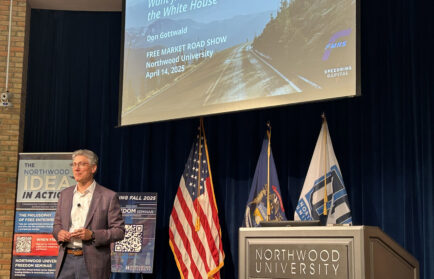The United States Declaration of Independence was not yet six months old when George Washington and his Continental Army found themselves crossing the Delaware River from Pennsylvania to New Jersey in late December to do battle against British and Hessian German soldiers at what became known as the Battle of Trenton.
In fact, Washington and his men crossed the river Christmas evening in 1776 and launched a surprise attack against enemy forces in New Jersey, giving colonial troops a much-needed victory. The victory in Trenton turned the tide in favor of the colonists, which set the stage for victory at the Battle of Yorktown in Virginia, and culminated in the establishment of the United States of America.
What many Americans do not realize, however, is that General Washington, perhaps America’s most famous founding father, never signed the Declaration of Independence. While the Declaration was being finalized and signed in Philadelphia, George Washington was in New York preparing the Continental Army for battle with England, which they knew would be a certainty once the British read the colonist’s declaration for freedom. Even though Washington did not sign the Declaration of Independence, it was up to him to implement it. He provided opportunity for hundreds of millions of future American dreams by literally creating the first and greatest American dream ever: The establishment of these United States of America.
The Declaration of Independence and American economic freedom
The Declaration of Independence rejected a monarchy, called for self-government, and placed limited control over people’s lives in the soon-to-be created nation. It boldly stated that all people are equal and that individuals had rights inherent in nature, endowed from a divine source.
The Declaration of Independence declared that all future Americans be able to pursue the promise of life, liberty, and happiness. However, the Declaration of Independence was not a governing document.
Upon victory at Yorktown, the “newly-freed” Americans began working on a Constitution to create a system of government that would be driven by liberty, and create the freest and most prosperous people in the world.
Along with political freedoms, the promise of the Declaration of Independence also created the foundation to establish the largest free-enterprise economy in the history of the world. That promise has largely been realized with America being the envy of the world, generating more than $21 trillion in GDP, far and away the world’s most successful. The following are four of the most important pillars of today’s American economy that find root in the Declaration of Independence and the U.S. Constitution.
U.S. Constitution. The U.S. Constitution created checks and balances over government by establishing three branches (executive, legislative and judicial). It also called for federalism, giving the vast majority of power to local and state governments. Finally, the founding fathers knew they had not created a perfect document, and needed to give the people the power and means when absolutely necessary to change and improve the Constitution, and therefore America, via an arduous and thorough process for amendments. Amendments eliminating slavery and giving women the right to vote are examples of the “living” nature and often “self-correcting mechanism” of this great document. There have been more than 11,000 proposed amendments to the U.S. Constitution, with only 27 adopted.
Free Enterprise. For more than 135 years, the founding fathers rejected a federal income tax and called for limited regulations of the economy, with most regulation being the purview of individual states.
Economic and Social Meritocracy. The founders desired to create a country where people were judged and succeeded based on their abilities and results rather than who they were and where they came from. Today, for example, the most rapidly growing demographic of new business owners and entrepreneurs are women and minorities.
Freedom and the Flow of Knowledge and Information. The establishment of property rights and freedom of the press allowed for investment in ideas and new businesses. It created a risk-taking entrepreneurial class that is the envy of the world today. Even though we complain about freedom of the press, that too is being litigated in the forum of public opinion, as we write this article.
Following his swearing-in as California Governor on Jan. 5, 1967, Ronald Reagan had this to say about freedom:
“Freedom is never more than one generation from extinction. We didn’t pass it on to our children in the bloodstream. The only way they can inherit the freedom we have known is if we fight for it, protect it, defend it, and then hand it to them with the well-fought lessons of how they in their lifetime must do the same. And if you and I don’t do this, then you and I may well spend our sunset years telling our children, and our children’s children what it once was like in America when men were free.”
This message is perhaps more appropriate today than when it was delivered to the people of California more than 55 years ago. Our national debt is now 121% of our U.S. GDP, growing from less than 35% of U.S. GDP when Ronald Reagan became president in 1981. We are over-regulating numerous industries from energy and automobiles to credit and fishing. And unfortunately, we adopted an income tax in 1913. According to the U.S. Congressional Budget Office, government consumption of our economy has grown from less than 8% of GDP in 1900 (local and state government 5%, federal government 2.8%) to roughly 42% today (local and state government 15%, federal government 27%). We believe 8% is too low to support our complex global economy, but hopefully, we all agree that 42% is excessive.
Let us all be thankful for General Washington and our founding fathers, the blessings, honor and privilege of living in America, and dedicate ourselves to increasing freedom in this great country, as part of our New Year’s resolution.
Dr. Timothy G. Nash is director of the McNair Center at Northwood University. This column originally was published on Townhall. It was co-authored by Dr. Thomas Rastin and Ohio State Sen. George Lang. Dr. Rastin is a retired energy executive. Sen. George Lang is a member of the Ohio Senate and represents the 4th District.





